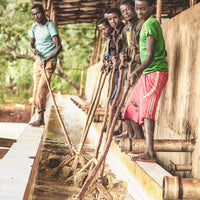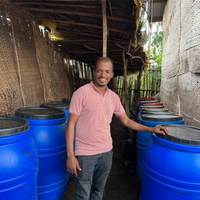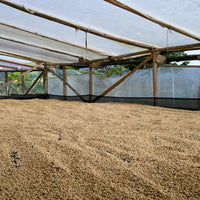Origin: El Salvador
Region: Santa Ana
Altitude: 1500 - 1550 meters above sea level
Farm: Chalchuapa, La Cumbre
Farm Size: 70 hectares
Owner: Emilio Lopez and Jose Roberto Santamaria
Variety: Geisha
Process: Washed
Tasting Notes: Harmonious and silky with notes of peach, honey, jasmine and lemon curd.
This Geisha lot from Emilio López and Jose Roberto Santamaría takes the high-quality Geisha variety and gives it the best care and attention from producers with generations of knowledge and passion for coffee production. The result is priceless.
This coffee is the product of Emilio López and Jose Roberto Santamaría’s multigenerational coffee producing families. They have a deep connection with their land and together, they joined forces to create Odyssey Coffees, an El Salvador and Portland-based coffee company.
Their operations are located on 6 farms: Fincas Las Isabellas, Tapantogusto, Las Piedras, La Cumbre, El Manzano and Ayutepeque.
When they merged their operations, Emilio and Jose worked together to ensure that they were using the same methods on all their farms and ensure that their quality is consistent and sustainable. They offer coffee to clients worldwide and have a strong recurring demand for their production.
Finca El Manzano was founded in 1872 and has been in Emilio López’s family for generations. He planted new varieties and built an on-site wet mill in 2005.
In order to support the producing communities near Finca Tequendama and Finca Las Isabellas, they created their project “Growing Together” in April 2021. They offered workshops for suppliers to help them increase their productivity and quality. They also offer medical assistance and educational programs for youth.
Cherry is selectively handpicked and delivered to El Manzano’s on farm wet mill. Ripe, red cherry is pulped. Then, coffee is fermented for 16 to 20 hours before being washed in clean water. Parchment is laid to dry on patios where it is raked frequently to ensure even drying. It takes approximately 7 to 10 days for parchment to dry.
Geisha (also known as Gesha) is known for its exceptional cup quality, especially when grown at high altitudes. The variety comes from Ethiopian landrace coffees and was collected from Ethiopian coffee forests in the 1930s. The name supposedly derives from Ethiopia’s Gori Gesha forest.
There is some confusion with several genetically distinct varieties that have all been called Geisha, but the most famous variety is the Panama one. The variety was brought to Lyamungu research station in Tanzania and from there to Centro Agronómico Tropical de Investigación y Enseñanza (CATIE) in Central America in 1953. At CATIE, the variety was logged as T2722. CATIE distributed T2722 across Panama in the 1960s for its Coffee Leaf Rust (CLR) resistance, but its brittle branches meant it was not widely planted.
Panama Geisha reached its modern fame in 2005 when a Geisha lot won the “Best of Panama” competition and broke contemporary records at over $20/pound. DNA analysis has demonstrated that the Panama Geisha descended from T2722 is distinct and uniform. Today, Geisha is known for its delicate florals, jasmine and stone fruit.
Don’t be fooled by El Salvador’s small size. It was once the 4th largest coffee producer worldwide and continues to produce high quality lots. The country is known for its great cupping varieties, such as Bourbon and Pacamara. In fact, two beloved, frequently high-scoring varieties—Pacas and Pacamara— originated in El Salvador.
Unlike other countries, where specialty coffee production has required a great deal of additional investment and training, El Salvador already has a broad and skilled specialty coffee workforce. Farming traditions run deep, and many Salvadorian farmers are extremely passionate about coffee production and continuously strive to improve their crop. El Salvador has optimal conditions for coffee processing. The prolonged dry season typically occurs during the harvest season, making it easier to sun dry coffee.
Though coffee output in the country has been declining for over two decades – exacerbated by the CLR crisis – the approach to coffee production has changed from volume- to quality-driven. A new generation of coffee producers has sprouted around the country with a new vision and approach to production. Many of this generation are experimenting with processing and varietals.







